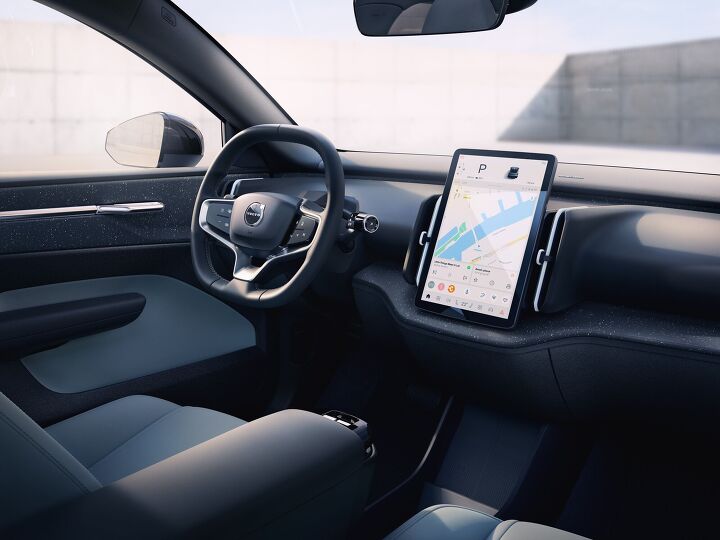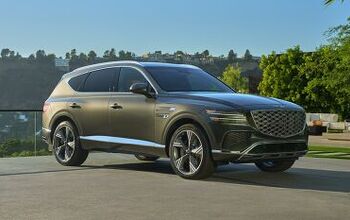Volvo Unveils Compact EX30 All-Electric SUV

Despite all-electric vehicles being heralded as environmentally sound solutions that would kick down the door to affordable mobility, there haven’t been a lot of good examples hitting the market recently. Most models are aimed at the affluent, resulting in 9,000-pound behemoths with six-figure price tags. General Motors recently released the absolutely ludicrous GMC Hummer EV while the Chevrolet Bolt is being discontinued.
Meanwhile, Volvo has introduced the EX30 — a pint-sized EV that’s to serve as the foundation of its all-electric transformation. But it’s difficult to say whether or not it’s going to deliver on those early promises of electrification.
Becoming the smallest vehicle in Volvo’s fleet means the EX30 utilizes less material overall. The manufacturer has also made it clear that the vehicle utilizes recyclable and renewable components where possible. But the car has also been streamlined in a number of ways that one could argue don’t make for a premium product.
Streamlining assembly so that the EX30 utilizes more stamped body panels is totally forgivable. However, some customers may not appreciate the barren interior. Minimalist design certainly has its place in the automotive realm. But it’s a fine line between offering a clean interior layout and one that’s missing things to save money.
“We know that price and cost of ownership is still one of the biggest challenges when people consider switching to an electric car,” said CEO Jim Rowan. “With the Volvo EX30, we aim to bring premium, fully electric mobility to a much broader audience, helping to advance and speed up the transition to full electrification that our industry and society needs.”
In the case of the EX30, you get a centrally mounted touchpad (12.3 inches) and some controls on the steering wheel. While akin to what’s found inside most modern Tesla vehicles, minimalist cabins certainly aren’t for everyone. Of course, Volvo will tell you that the interior is empty for the sake of sustainability as it tries to convince you that the trend is cutting edge.
It’s basically a smaller, stripped-down version of the Volvo C40 Recharge and looks to be what most manufacturers are hoping to deliver with their bottom-rung EVs.
The 2025 Volvo EX30 is 166.7 inches long, 72.3 inches wide, and 61.1 inches tall. That’s relatively petite, making the Volvo similar in size to a squat Jeep Renegade. But the fact that it uses a battery pack means interior volume shouldn’t be all that bad. Storage seems middling with 14 cubic feet of space behind the back seats (32 cubes they’re folded). But there are supposed to be bins and cubbies just about everywhere.
Riding on the Sustainable Experience Architecture (SEA) electric platform that was developed by Chinese-parent Geely, the EX30 can be had with either a single rear motor (268 horsepower and 253 pound-feet of torque) or a dual-motor setup (422 hp and 400 pound-feet) offering all-wheel drive.
In the latter configuration, Volvo said the hatchback can hit 60 mph in just 3.4 seconds. That’s exceptionally good, though we doubt it packs the same punch when rolling on the power from highway speeds.
The standard battery pack is 64.0 kWh and Volvo has suggested it’s capable of yielding 275 miles of range when paired with a single motor. While the dual-motor EX30 is presumed to lose a few miles, it’s really going to come down to how aggressively you drive it and whether the EPA backs up those figures. Either way, the manufacturer said DC fast charging should recoup a 10 to 80 percent state of charge in about 27 minutes.
Volvo has promised a comprehensive safety suite, the latest version of Park Pilot Assist, and plenty of electronic nannies. This includes a driver-attention monitor that basically your author is wholly against due to privacy concerns. But those systems are becoming obligatory in Europe and industry lobbying groups seem interested in adding them.
The base model is already available for pre-order and coming to the United States for an estimated $36,145. That’s about what we’d expect from an EV of this size. But it still seems a little expensive and we don’t know which EV tax credits it’ll be eligible for due to it being produced inside of China. Localized assembly may eventually manifest at Volvo's South Carolina plant. However, the company was not able to confirm anything at this juncture.
Expect the Plus and a top-level Ultimate version of the EX30 to come in a few thousand above the initial Core trim. Volvo has said it also plans on offering a Cross Country variant with more ground clearance, tons of black plastic on the exterior, and an optional set of BFGoodrich All-Terrain T/A KO2 tires. But we'll probably need to wait another year on that one.
[Images: Volvo Cars]
Become a TTAC insider. Get the latest news, features, TTAC takes, and everything else that gets to the truth about cars first by subscribing to our newsletter.

A staunch consumer advocate tracking industry trends and regulation. Before joining TTAC, Matt spent a decade working for marketing and research firms based in NYC. Clients included several of the world’s largest automakers, global tire brands, and aftermarket part suppliers. Dissatisfied with the corporate world and resentful of having to wear suits everyday, he pivoted to writing about cars. Since then, that man has become an ardent supporter of the right-to-repair movement, been interviewed on the auto industry by national radio broadcasts, driven more rental cars than anyone ever should, participated in amateur rallying events, and received the requisite minimum training as sanctioned by the SCCA. Handy with a wrench, Matt grew up surrounded by Detroit auto workers and managed to get a pizza delivery job before he was legally eligible. He later found himself driving box trucks through Manhattan, guaranteeing future sympathy for actual truckers. He continues to conduct research pertaining to the automotive sector as an independent contractor and has since moved back to his native Michigan, closer to where the cars are born. A contrarian, Matt claims to prefer understeer — stating that front and all-wheel drive vehicles cater best to his driving style.
More by Matt Posky
Latest Car Reviews
Read moreLatest Product Reviews
Read moreRecent Comments
- Varezhka I have still yet to see a Malibu on the road that didn't have a rental sticker. So yeah, GM probably lost money on every one they sold but kept it to boost their CAFE numbers.I'm personally happy that I no longer have to dread being "upgraded" to a Maxima or a Malibu anymore. And thankfully Altima is also on its way out.
- Tassos Under incompetent, affirmative action hire Mary Barra, GM has been shooting itself in the foot on a daily basis.Whether the Malibu cancellation has been one of these shootings is NOT obvious at all.GM should be run as a PROFITABLE BUSINESS and NOT as an outfit that satisfies everybody and his mother in law's pet preferences.IF the Malibu was UNPROFITABLE, it SHOULD be canceled.More generally, if its SEGMENT is Unprofitable, and HALF the makers cancel their midsize sedans, not only will it lead to the SURVIVAL OF THE FITTEST ones, but the survivors will obviously be more profitable if the LOSERS were kept being produced and the SMALL PIE of midsize sedans would yield slim pickings for every participant.SO NO, I APPROVE of the demise of the unprofitable Malibu, and hope Nissan does the same to the Altima, Hyundai with the SOnata, Mazda with the Mazda 6, and as many others as it takes to make the REMAINING players, like the Excellent, sporty Accord and the Bulletproof Reliable, cheap to maintain CAMRY, more profitable and affordable.
- GregLocock Car companies can only really sell cars that people who are new car buyers will pay a profitable price for. As it turns out fewer and fewer new car buyers want sedans. Large sedans can be nice to drive, certainly, but the number of new car buyers (the only ones that matter in this discussion) are prepared to sacrifice steering and handling for more obvious things like passenger and cargo space, or even some attempt at off roading. We know US new car buyers don't really care about handling because they fell for FWD in large cars.
- Slavuta Why is everybody sweating? Like sedans? - go buy one. Better - 2. Let CRV/RAV rust on the dealer lot. I have 3 sedans on the driveway. My neighbor - 2. Neighbors on each of our other side - 8 SUVs.
- Theflyersfan With sedans, especially, I wonder how many of those sales are to rental fleets. With the exception of the Civic and Accord, there are still rows of sedans mixed in with the RAV4s at every airport rental lot. I doubt the breakdown in sales is publicly published, so who knows... GM isn't out of the sedan business - Cadillac exists and I can't believe I'm typing this but they are actually decent - and I think they are making a huge mistake, especially if there's an extended oil price hike (cough...Iran...cough) and people want smaller and hybrids. But if one is only tied to the quarterly shareholder reports and not trends and the big picture, bad decisions like this get made.









































Comments
Join the conversation
The interior is obviously a Model 3 clone, but the screen is substantially smaller.
Incidentally, I suspect Tesla made the Model 3/Y interior so minimalist to save money - not just to be different. When you're trying to become profitable on EVs, every dollar counts.
I much prefer the normal gauges and buttons on my 19 Ioniq 1, which was a big selling point for me. This arrangement was due to other versions of the Ioniq being a hybrid and a PHEV.
This would be a great graduation present for the daughter.